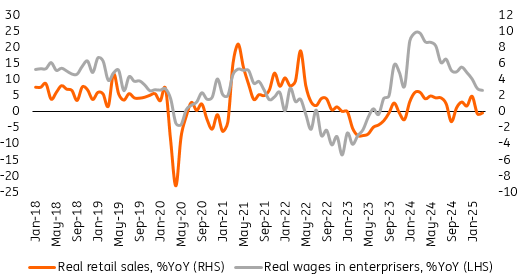
Image Source: Pexels
The nearly complete data from the real economy for 1Q25 indicates that annual growth was slower than the 3.4% year-on-year achieved in 4Q24. Both industrial output and retail sales have decelerated, with construction the only sector showing improvement. Due to elevated uncertainty, the mid-term outlook is shaky.
Retail sales fell by 0.3% year-on-year in March, following a 0.5%YoY decline in February. As expected, the “Easter effect” weighed on consumer spending on goods. In 2024, Easter purchases took place in March, which boosted the reference base, whereas in 2025 Easter was celebrated in mid-April. This dampened purchases of food (-9.4%YoY) and in the “other” category (-12.2%YoY).
On a positive note, purchases of durable goods were encouraging. Double-digit increases in purchases were reported in passenger cars (+18.4%YoY) as well as furniture, consumer electronics and house appliances (+12.9%YoY).
Sales eased with slower wages growth
Retail sales and wages in enterprises (real),%YoY

Source: GUS, ING.
The beginning of the year was not particularly impressive for the Polish economy. Annual growth of industrial production and retail sales eased in the first quarter of 2025 versus the fourth quarter of 2024. The only sector that showed some improvement was construction, albeit from a very poor performance in 2024. Based on the available data, we estimate that in the first quarter of the year, GDP growth fell short of the 3.4%YoY reported in the fourth quarter of 2024.
The state of the economy is evidently not indicative of a pro-inflationary boom, and the balance of risks for GDP growth ahead is tilted to the downside, partly due to uncertainty linked to American trade policy that may hinder international trade in goods.
At the same time, both CPI and core inflation at the beginning of 2025 were below both the March National Bank of Poland (NBP) projection and market expectations. Wage growth in enterprises also slowed in early 2025, and the spike in electricity prices for households in the final quarter of this year is unlikely.
In such an environment, the Monetary Policy Council is likely to ease monetary policy in May, and policymakers will debate whether the first rate cut should be 25bp or 50bp. In our view, the latter is more likely, and by the end of the year, interest rates may be reduced by 125bp.
More By This Author:
FX Daily: Bessent Throws US Assets A Lifeline The Commodities Feed: The Door Opens For Tariff De-Escalation South Korean Consumer Sentiment Remains Weak, Weighing On Growth
Disclaimer: This publication has been prepared by the Economic and Financial Analysis Division of ING Bank N.V. (“ING”) solely for information purposes without regard to any ...
more
Disclaimer: This publication has been prepared by the Economic and Financial Analysis Division of ING Bank N.V. (“ING”) solely for information purposes without regard to any particular user's investment objectives, financial situation, or means. ING forms part of ING Group (being for this purpose ING Group NV and its subsidiary and affiliated companies). The information in the publication is not an investment recommendation and it is not investment, legal or tax advice or an offer or solicitation to purchase or sell any financial instrument. Reasonable care has been taken to ensure that this publication is not untrue or misleading when published, but ING does not represent that it is accurate or complete. ING does not accept any liability for any direct, indirect or consequential loss arising from any use of this publication. Unless otherwise stated, any views, forecasts, or estimates are solely those of the author(s), as of the date of the publication and are subject to change without notice.
The distribution of this publication may be restricted by law or regulation in different jurisdictions and persons into whose possession this publication comes should inform themselves about, and observe, such restrictions.
Copyright and database rights protection exists in this report and it may not be reproduced, distributed or published by any person for any purpose without the prior express consent of ING. All rights are reserved. ING Bank N.V. is authorised by the Dutch Central Bank and supervised by the European Central Bank (ECB), the Dutch Central Bank (DNB) and the Dutch Authority for the Financial Markets (AFM). ING Bank N.V. is incorporated in the Netherlands (Trade Register no. 33031431 Amsterdam). In the United Kingdom this information is approved and/or communicated by ING Bank N.V., London Branch. ING Bank N.V., London Branch is deemed authorised by the Prudential Regulation Authority and is subject to regulation by the Financial Conduct Authority and limited regulation by the Prudential Regulation Authority. The nature and extent of consumer protections may differ from those for firms based in the UK. Details of the Temporary Permissions Regime, which allows EEA-based firms to operate in the UK for a limited period while seeking full authorisation, are available on the Financial Conduct Authority’s website.. ING Bank N.V., London branch is registered in England (Registration number BR000341) at 8-10 Moorgate, London EC2 6DA. For US Investors: Any person wishing to discuss this report or effect transactions in any security discussed herein should contact ING Financial Markets LLC, which is a member of the NYSE, FINRA and SIPC and part of ING, and which has accepted responsibility for the distribution of this report in the United States under applicable requirements.
less
How did you like this article? Let us know so we can better customize your reading experience.





